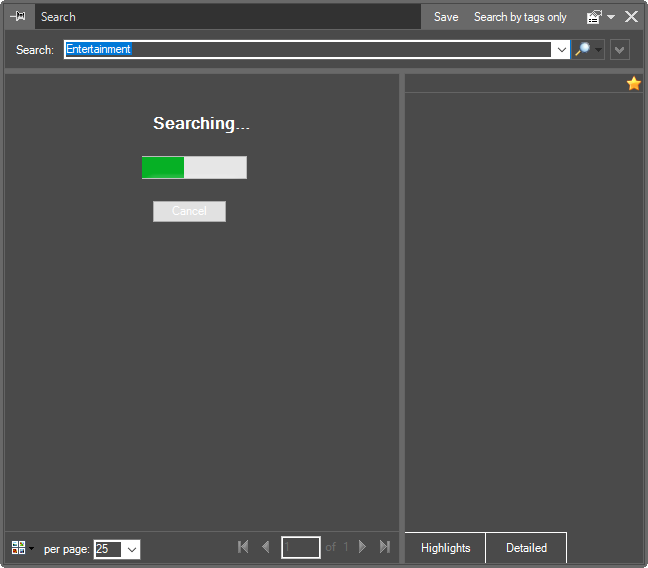Search Modes
Reading time ~8 minutes
Simple Search
To start searching, enter your request in the "Search" field and hit Enter or press the  button.
button.
|
Simple "Search" window |
|
If the searching operation takes too long or it is necessary to correct/change the request, press the "Cancel" button to stop the searching process. |
|
Note
|
The Cinegy Desktop search function looks for different object types that contain the search word in the name or in the metadata. |
|
Note
|
Please note that news items are excluded from Cinegy Desktop Search. Use Cinegy Newswire Browser to search for news items in the Cinegy Archive database. |
Press the "Search by tags only" button to perform search only by the data entered in the "Tags" metadata field.
|
Note
|
If there are problems with the search query, the corresponding errors will be added to the System Log. |
Search Request Syntax
You can use multiple words for search. In this case, they are connected with the logical AND. You can also use the AND, OR and NOT operators, as well as brackets. If you enter several words separated by a space, the operator AND is assumed.
The wildcard * is also allowed.
By default, the words in search query that are shorter than 3 characters are not searchable. If such a word is a part of a disjunction, the whole phrase is not searchable too.
|
Important
|
The minimal search query length can be changed via Cinegy Archive Manager. Refer to the Search paragraph in the Cinegy Archive Manager Manual for details. |
The following tables explain the search request syntax.
Expressions
|
Note
|
Please note that SQL Server Full-Text Search considers punctuation and non-alphanumeric characters as separators, therefore they are processed by SQL Server Search Engine as logical OR in query operations. For example, a search on black&white (either black.white or black;white etc.) will be processed by Search Engine as separate words presenting the same search results as for black OR white query. |
| Expression | Description | ||
|---|---|---|---|
any word |
All the forms of that word
|
||
"string" |
The exact string |
||
* |
Any string of zero or more characters/words according to the defined narrowing parameters |
||
? |
Any single character |
||
[^] Wildcard - Character(s) Not to Match |
Matches any single character that is not within the range or set specified between the square brackets
|
||
"%exact phrase%" |
The exact word combination or phrase |
||
[] Wildcard - Character(s) to Match |
Matches any single character within the specified range or set that is specified between brackets [ ]
|
||
a word expression with a space ( where space is equivalent to AND operator) |
Any strings that contain all occurrences of the query terms grouped by AND |
|
Note
|
If the "?" symbol is placed at the beginning or the end of the word, it is processed as the "*" wildcard, i.e. "?" will be substituted by one or more characters. |
Operators
| Operator | Shortcut | Description | Example |
|---|---|---|---|
AND |
& or space |
Logical AND |
red monkey |
OR |
| or period |
Logical OR |
Joe | Willy |
NOT |
~ |
Logical NOT |
Joe NOT Willy ~fish & ~meat |
( ) |
Logical grouping |
(~red monkey) | (John Smith) |
|
LIKE, NOT LIKE |
LK, NL |
Matching a specified pattern |
LIKE *land |
|
Note
|
Please note, when using a NOT operator in your search query the search process may take a long time, especially in large databases. It is recommended to avoid using the NOT operator, wherever possible. |
The table below shows possible search results when querying specific examples.
|
Note
|
The following given objects were used in search queries: Entire New Placeholder MOGs (Master Clip), Clip Description = "myseq007", itismyseq,My.New.Placeholder MOGs, myseq, *myseq*, myseq001, New.ClipBin, New ClipBin, new.seq003, new.seq006, Old;ClipBin, Old.ClipBin. |
| Example Query | Search Results | ||
|---|---|---|---|
man |
man and men |
||
"*myseq*" |
*myseq* |
||
man* |
man, many, manuscript, manner, manual control, man of the year and so on. |
||
?ean |
Dean, Sean and so on. |
||
[C-P]arsen |
Carsen, Larsen, Karsen and so on. |
||
*[.]clipbin |
New.Clipbin, Old.Clipbin |
||
new clipbin |
New.Clipbin, New Clipbin, New;ClipBin |
||
"%folder #1%" |
folder #1 |
||
new[.]seq* |
new.seq003 ( but not "new;s.eq006," not "ne.w.seq006" etc.) |
||
new.clipbin |
Entire New Placeholder MOGs, New.ClipBin, New ClipBin, new.seq003, Old;ClipBin, Old.ClipBin |
||
*clipbin |
New.ClipBin, New ClipBin, Old;ClipBin, Old.ClipBin |
||
*[.]* |
My.New.Placeholder MOGs, New.ClipBin, new.seq003, new.seq006, Old.ClipBin
|
||
new[^.]clip* |
New ClipBin, New;ClipBin |
||
my[.]*lde* |
New.ClipBin, My.New.Placeholder MOGs, My.New.Placeholder MOGs 00:00:00:00 (master clip)
|
||
new[.]seq00? |
new.seq003, new.seq006 |
||
*myseq* |
itismyseq, myseq, *myseq*, myseq001 |
|
Caution
|
The latest Cinegy DB Wizard patch should be applied to ensure proper search results. |
|
Note
|
The search results can differ depending on Microsoft SQL Server editions and languages due to particular implementations. |
|
Note
|
When using the expression with a range of symbols (written in square brackets) and performing search within some text rather than searching for a single word, add the "*" symbol at the beginning and the end of the search expression. For example, if you are searching within some text for the words starting with any symbol of the [b-t] range and the second part of which is "end", use the following search expression: *[b-t]end*. |
|
Note
|
When using the "%exact phrase%" expression, please note that the search process may take a long time, especially in large databases. |
Auto-Complete Functionality
During a session the system will remember the words you have entered into the search window. These will be added to the drop-down list. So if you would like to repeat a specific search, you can select the word(s) from the drop-down list.
The search interface also supports the auto-complete functionality. So when you start typing a new search request, the system checks the previous search request and if it recognizes the word, it will suggest this word to you.

If there are several words that match, the system will open the drop-down list with all the matching words. Now you can simply select the right word from the list or continue typing in the new word if the results do not correspond with what you wanted to search for.

Fuzzy Search
The search functionality suggests an alternative result when any word of the phrase entered in the "Search" field is misspelled:

|
Note
|
The "Did you mean" link is displayed only when Cinegy Search finds at least one misspelling in the search phrase. |
The suggested phrase is displayed in the "Search" dialog box as a link. When user clicks it, a new search session is started using the corrected query as a new search request.
Advanced Search
Advanced search allows more sophisticated search requests regarding clip names and metadata fields.
Press the  button next to the search field to show/hide the advanced search options in the "Search" dialog box.
button next to the search field to show/hide the advanced search options in the "Search" dialog box.
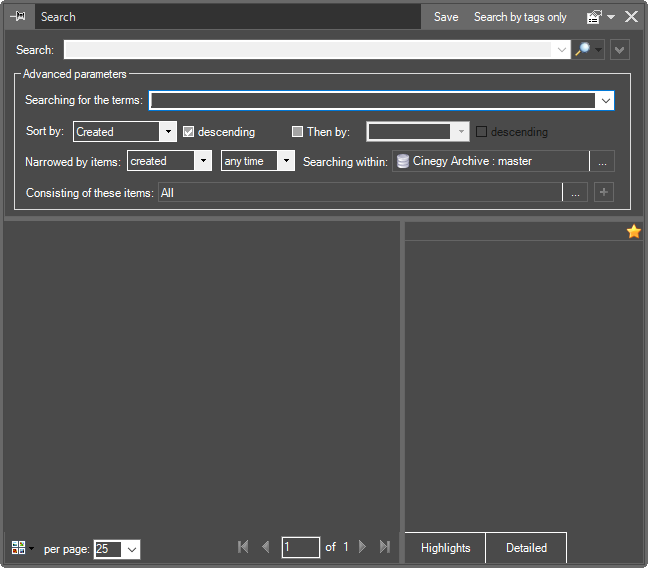
|
Note
|
Cinegy Newswire Service is excluded from the Advanced search by default. Cinegy Newswire Service has its own dedicated Cinegy Newswire Browser that provides a convenient interface for search. |
Advanced Parameters
Enter your search request in the "Searching for the terms" field.
|
Important
|
Wildcards "*" and "?" are allowed for the advanced search. When a wildcard is used, the search operation is more time consuming. Refer to the Auto-Complete Functionality and Search Request Syntax paragraphs to learn about using the syntax properly. |
Sorting the Search Results
The search functionality supports the ability to define sorting criteria for your search results. To set the primary sorting criterion, select the desired option for the "Sort by" list:
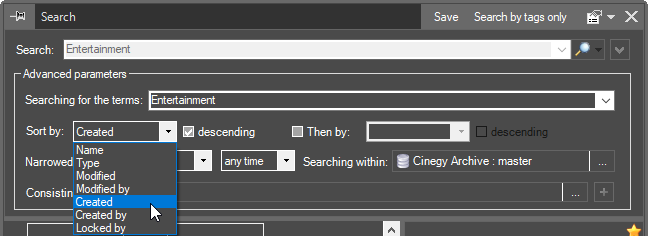
Select the "descending" checkbox to arrange your search results in descending order or leave this option not selected to use ascending order.
To enable the secondary sorting criterion, select "Then by" and choose the desired option from the drop-down list:
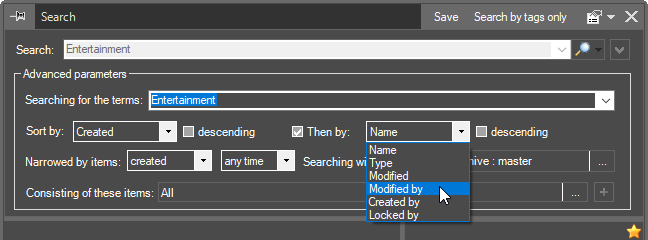
|
Note
|
The defined primary sorting criterion value will not appear in the "Then by" drop-down list. |
For the second criterion you can also define descending/ascending order by selecting the "descending" checkbox or leaving it empty.
Narrowing Search Results
The search functionality provides the ability to narrow the search by the time of creation or modification. To narrow your search, select whether the assets were created or modified at the specified time:

|
Note
|
When using only wildcard "*" as a search query, it is necessary to define the narrowing parameters; nothing will be found otherwise. |
Then select the time scale:
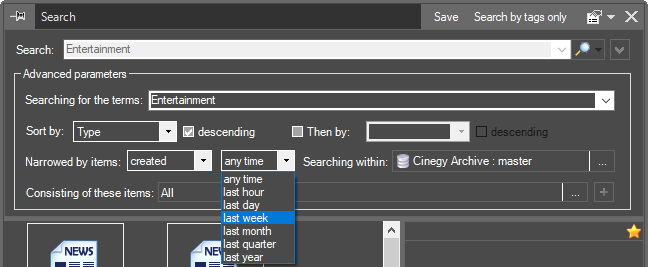
You can also define the search location in the "Searching within" field. Press the "…" button and define the search location using the "Searching within" dialog:
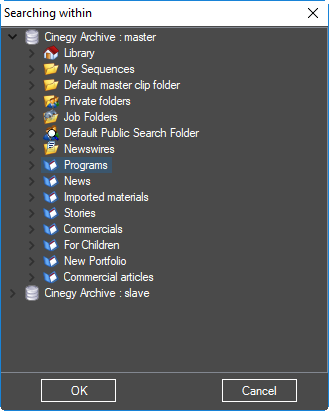
By default, the search is performed in all node types. To search only for specific node types, press the "…" button next to the "Consisting of these items" field and select the desired asset type(s):
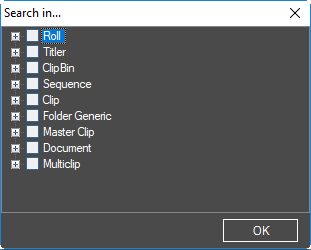
Conditions on Metadata Fields
You can make additional limitations to your search. This can be done by adding conditions to the metadata fields. To do this, add a row in the bottom part of the advanced parameters configuration group by pressing the  button.
button.
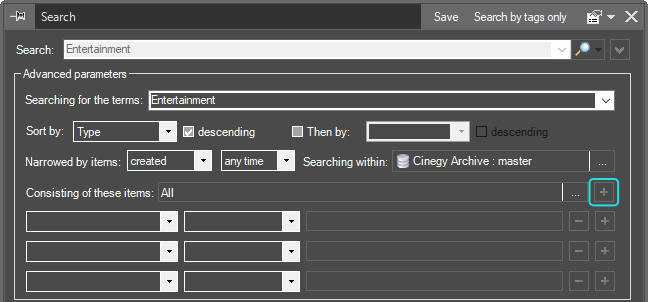
|
Note
|
You can add as many rows to limit your search request as you need. |
To select the metadata property field, choose the desired one from the pull-down menu on the left:
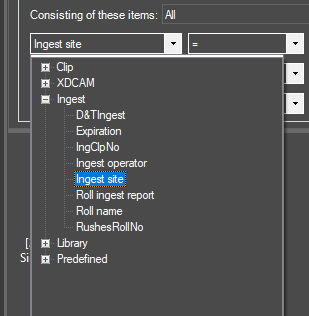
If, for example, you would like to search for the assets with the specific ingest location, select the "Ingest site" field from the list.
|
Note
|
The list of metadata fields available for your selection depends on your database settings. |
You can also state if the property should contain or not contain the value you will be entering next.

Depending on the selected metadata property field, you can either enter the value field via the keyboard or select the corresponding option from the drop-down list.
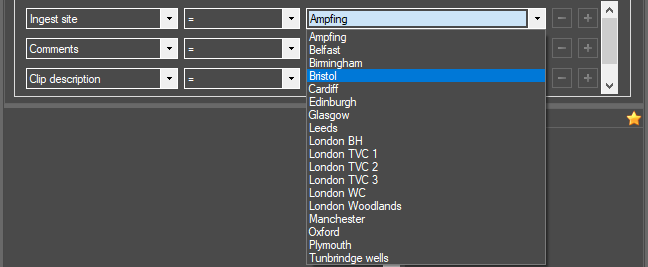
|
Note
|
The drop-down list options depend on your database settings and can vary from those shown in the example above. |
To remove the condition field(s), press the  button.
button.
